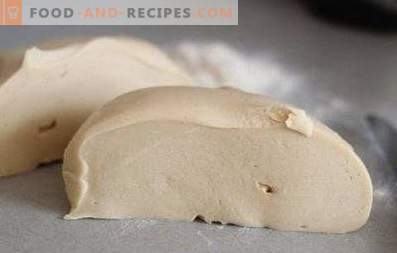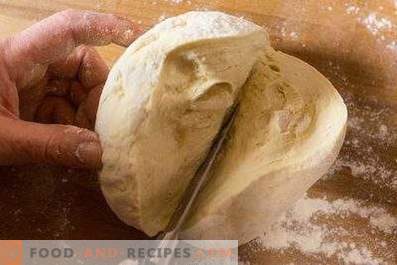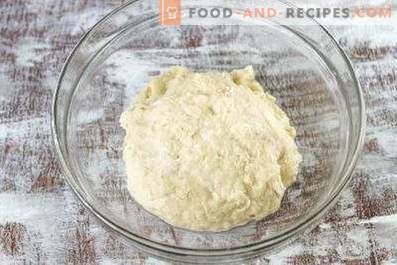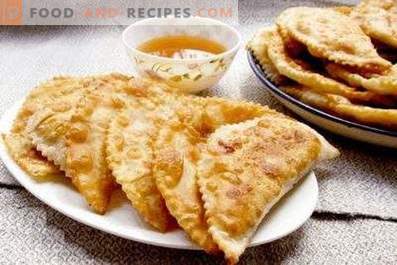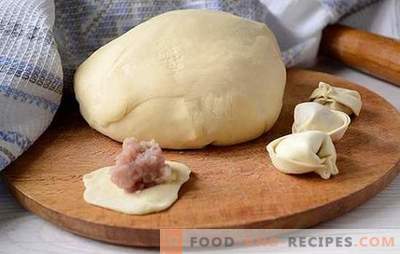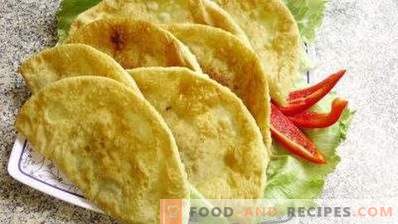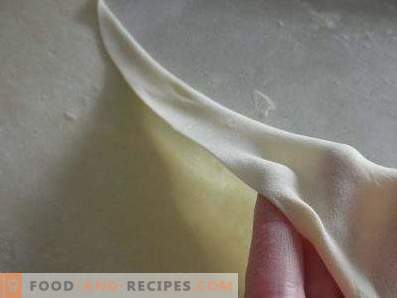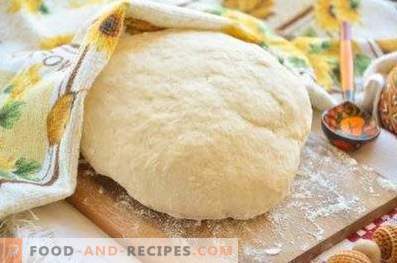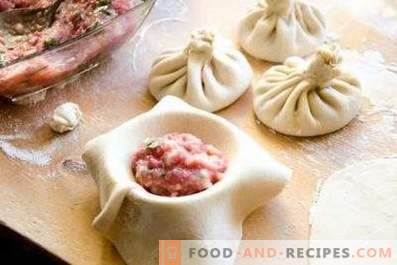
Khinkali is a Georgian dish resembling Siberian dumplings, Ukrainian dumplings and Uzbek manti. These are bags of unleavened dough, boiled in water or steamed, usually filled with meat, less often with vegetables. They are quite large, but the Georgians eat them in large quantities and sometimes even compete, who will eat more such items (counting is based on the tails left over from the bags). They eat khinkali in a special way: they are taken by the tails, nibble, drink broth, then eat the rest, leaving only the tails. If the cooking broth from the products is poured out because of the broken shell, the Georgian cook will consider it a great failure. The dough for khinkali should be elastic, but strong, only then Georgian dumplings will come out as they should be. The traditional recipe of the tavern dough is extremely simple, but modern cooks have come up with others, so the hostess has a choice on what to knead the dough, whether to add eggs or butter to it.
Cooking Features
The dough for khinkali is rolled thinly, the thickness of the flour casing should be about 2 mm, the width of the round cake in which the filling will be “packed” is 12-15 cm. The weight of the filling and the dough should ideally be the same. The filling is placed in the center. Then lift the edges of the cakes and form a kind of bag with filling. Its tail symbolizes the sun, and the folds - the rays. It is believed that there should be at least 18 of them, but some chefs manage to make more than 30 folds - this is considered to be the pinnacle of chef-making. Then they put the khinkali in boiling water and wait for them to turn over. After that, they boil for 10-12 minutes. If the dough is rolled thickly, it will not boil well, and the filling inside will be too little. The fragile dough will break through during cooking, which will cause the hinkali to lose both their beautiful shape and unique taste. From the description of the technology of preparation of these products it is clear how important it is to make an elastic, pliable, but durable, non-soaking dough for them. Recipes are simple, but ignorance of some points can lead to a fiasco.
- Flour for khinkali is better to choose high quality. It has more gluten, which is responsible for the elasticity of the dough. Products from it have a more pleasant taste and color.
- Flour must be sifted before use, experienced cooks do it even twice. The main goal is not to rid the product of small litter and flour moth larvae. The meaning of this manipulation is to saturate the flour with oxygen. After sifting, it becomes light, well combined with other ingredients without the formation of lumps. Products from it turn out more gentle.
- The temperature of the products used to make the dough may depend on the specific recipe. Relevant recommendations should not be ignored, since the final result depends on their observance.
- After kneading, the dough is not used immediately - it is allowed to rest for half an hour. During this time, the gluten contained in the flour has time to swell, as a result of which the dough becomes more malleable. So that during this time the dough does not become chapped, it is smeared with vegetable oil, placed in a plastic bag or wrapped with cling film.
- A traditional khinkali dough consists of water, flour, and salt, but oil or eggs are often added to it. With eggs, the dough turns out to be denser and more durable, but some Georgians believe that eggs do not belong in the khinkali test, since their addition gives the food to resemble dumplings or noodles. Vegetable oil is included in the recipe to make the dough more elastic, with it it rolls out well, without tightening back. If you know what additives are responsible for what, you will be able to find the best recipe.
Khinkali dough can be frozen and stored in a freezer for 2 to 4 months, depending on the recipe used. After defrosting, it can become sticky, this problem is solved by adding a small amount of sifted flour.
Simple khinkali test recipe
Composition:
- wheat flour - 0.5 kg;
- cold water - 0, 25 l;
- salt - 5 g.
Method of preparation:
- Sift flour and mix with salt. Make a funnel in the center of the flour heap.
- Boil and cool the water. Pour it into a glass, put in a freezer for 10 minutes.
- Pour ice water into the prepared funnel, stir the products with a spoon, then finish the process of kneading the dough with your hands.
- Collect the dough in a lump, place in a plastic bag and leave for half an hour at room temperature.
This recipe for khinkali dough is simple, and it is difficult to make a mistake when mixing it even for an inexperienced cook. Moreover, this particular recipe is considered a classic.
Choux pastry for khinkali
Composition:
- wheat flour - 0.5 kg;
- water - 0, 2 l;
- refined vegetable oil - 50 ml;
- salt - 5 g.
Method of preparation:
- Sift flour.
- Pour water into the pan, add oil and salt to it.
- Bring the mixture to a boil.
- Make a well in the flour heap, pour hot liquid into it.
- Stir the ingredients as quickly as possible with a spoon or spatula to brew the flour.
- Sprinkle flour on the table, put dough on it, knead it with your hands. Knead the dough until it becomes elastic and does not cease to stick to the hands.
- Grease the dough with vegetable oil and leave on the table for 30-40 minutes.
After a specified time, you can proceed to rolling out the dough and forming products. Choux dough does not crack when frozen, so you can prepare khinkali from it for future use.
Dough for khinkali on water with an egg
Composition:
- wheat flour - 0, 6 kg;
- water - 0, 3 l;
- chicken egg - 1 pc .;
- refined vegetable oil - 40 ml;
- salt - 10 g.
Method of preparation:
- Boil water and cool to room temperature.
- In the bowl, break the egg, salt it, stir it with a fork or a whisk.
- Pour water and oil into the egg, whisk it with a whisk to form a homogeneous liquid mixture.
- Sift flour. In portions, pour it into a bowl with a liquid mixture, stirring constantly and thoroughly to prevent lumps from forming.
- When it becomes difficult to stir the dough with a spoon, transfer it to the floured work surface of the table and complete the kneading process with your hands.
- Make a bun from the dough, wrap it with cling film, leave it at room temperature for half an hour.
The dough for this recipe is flexible and durable. It rolls out well, and the cook does not need to worry that it will break during the boiling of the khinkali.
Dough for khinkali on kefir
Composition:
- wheat flour - 0, 6 kg;
- kefir - 0, 3 l;
- chicken egg - 1 pc .;
- salt - 5 g.
Method of preparation:
- Remove the kefir and egg from the refrigerator in advance, so that they can warm up to room temperature by the beginning of the dough.
- Break eggs into a bowl, stir with salt.
- Pour kefir into the egg. Whisk the products with a whisk.
- Gradually sprinkle the sifted flour, knead moderately dense, not sticking to the hands of the dough. Flour may require a little less or more than indicated in the recipe - a lot depends on the stickiness of the flour, egg size, kefir fat content.
- Having formed a ball from the dough, wrap it with cling film and leave to rest for 30 minutes.
The dough, mixed with kefir, turns out to be elastic even without adding butter. To taste the products from it go soft, gentle.
Pink dough for khinkali with beet juice
Composition:
- beets - 0, 3 kg;
- water - 0, 2-0, 3 l;
- refined vegetable oil - 40 ml;
- wheat flour - 0 65 kg;
- salt - 10 g.
Method of preparation:
- Wash raw beets, peel, cut into pieces. Grind grated or in a food processor, squeeze the juice.
- Dilute beetroot juice with boiled water, bringing its volume to 0, 35 l.
- Mix the resulting liquid with salt and oil.
- Sifting flour, make a recess in it. Pour the prepared liquid mixture into it. Knead the dough.
- Allow the dough to rest, brushing with vegetable oil for protection from weathering, for 30 minutes.
Khinkali made of pink dough look unusual, but very appetizing. They will become even more beautiful if they are poured with oil mixed with pepper.
Dough for khinkali is done quite simply, it is important only to strictly follow the technology of its preparation. Then this Georgian dish will turn out the way it should be: with a thin shell and juicy filling.


